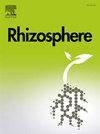Silicon drives distinctly the bacterial community in the rhizosphere of maize and common bean
IF 3.4
3区 生物学
Q1 PLANT SCIENCES
引用次数: 0
Abstract
Silicon (Si) has been recognized as a beneficial nutrient for plants, though its effect on microbial communities within the rhizosphere remains poorly understood, particularly when comparing plant species. This study assessed the effect of Si on the bacterial community in the rhizosphere of two distinct plant species, i.e., common bean and maize, under field conditions. The experiment compared two doses of Si (0 and 12 kg ha⁻1), applied via fertigation, on the bacterial community in the rhizosphere of both species using a randomized complete block design. Soil samples from the rhizosphere were collected at the pod formation stage (R7) for common bean and the tasseling stage (V) for maize. DNA was extracted, and the V4 region of the 16S rRNA gene was sequenced using the Illumina platform. The application of Si slightly separated the bacterial communities in the rhizosphere of both plant species. While Si did not affect bacterial richness and diversity in the rhizosphere of common bean, the rhizosphere of maize showed higher bacterial richness and diversity without Si. The co-occurrence network complexity showed less variation in the rhizosphere of common bean in response to Si, whereas maize exhibited more significant differences between treatments with and without Si. The rhizosphere of maize treated with Si had a higher number of edges (32,729) and positive interactions (10,749) compared to the treatment without Si. This study demonstrated that the bacterial communities in the rhizosphere of maize and common bean respond differently to Si, with Si having a greater impact on the bacterial community in the rhizosphere of maize than in common bean.
求助全文
约1分钟内获得全文
求助全文
来源期刊

Rhizosphere
Agricultural and Biological Sciences-Agronomy and Crop Science
CiteScore
5.70
自引率
8.10%
发文量
155
审稿时长
29 days
期刊介绍:
Rhizosphere aims to advance the frontier of our understanding of plant-soil interactions. Rhizosphere is a multidisciplinary journal that publishes research on the interactions between plant roots, soil organisms, nutrients, and water. Except carbon fixation by photosynthesis, plants obtain all other elements primarily from soil through roots.
We are beginning to understand how communications at the rhizosphere, with soil organisms and other plant species, affect root exudates and nutrient uptake. This rapidly evolving subject utilizes molecular biology and genomic tools, food web or community structure manipulations, high performance liquid chromatography, isotopic analysis, diverse spectroscopic analytics, tomography and other microscopy, complex statistical and modeling tools.
 求助内容:
求助内容: 应助结果提醒方式:
应助结果提醒方式:


